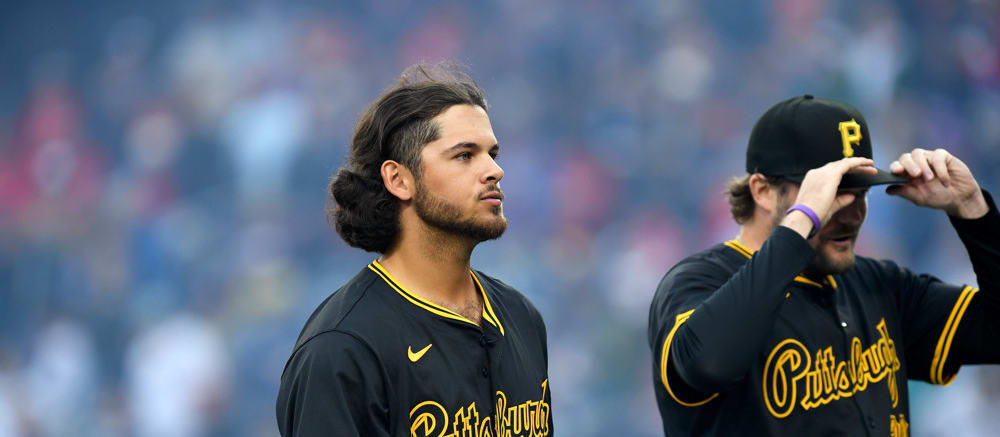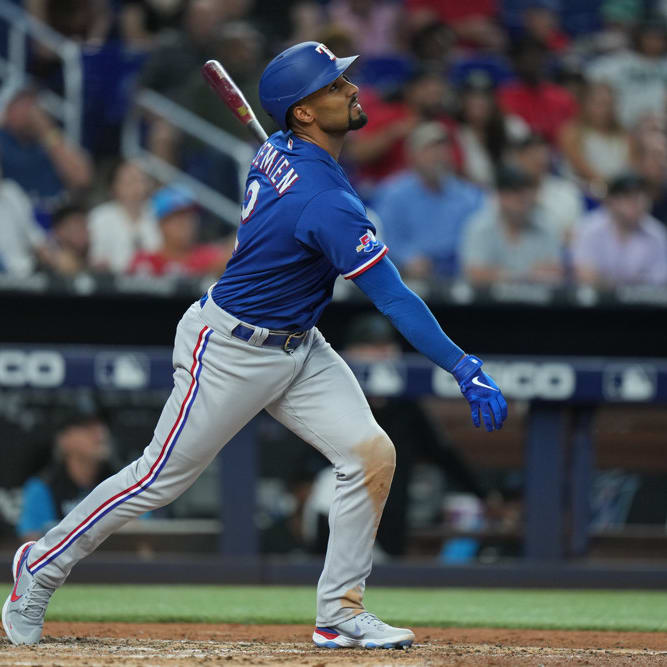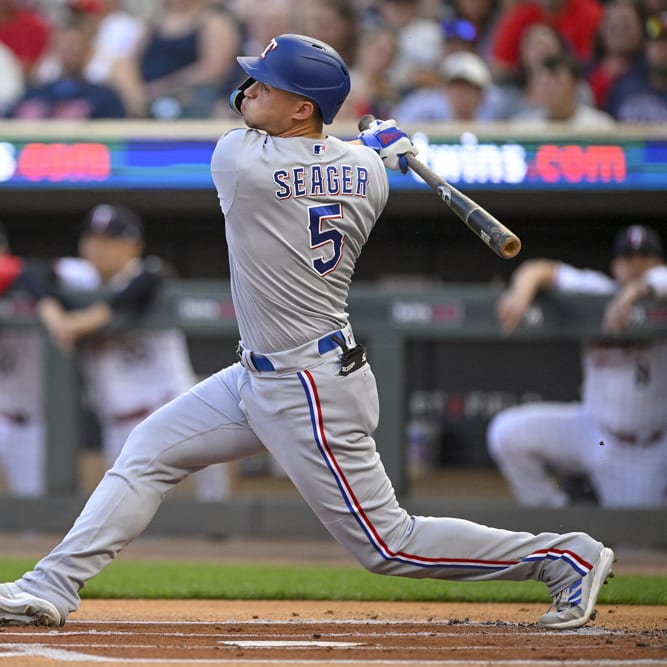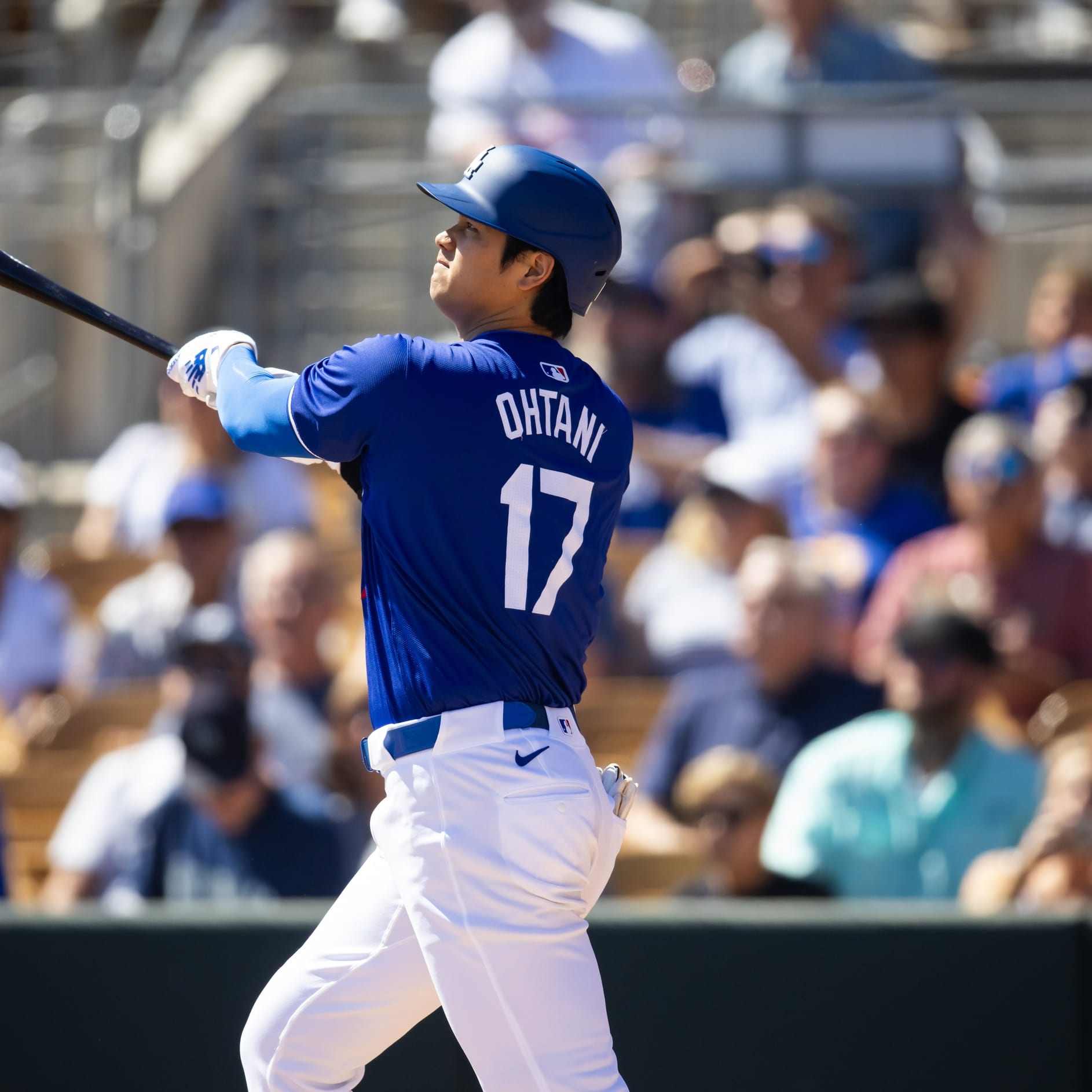What started as a quick bit of research for this week's MLB Barometer introduction turned into a full-length article. As a result, my next MLB Barometer will be delayed by a few days, but enjoy this article on the most exciting rookie pitcher in baseball instead.
Jared Jones was a known prospect heading into this spring, but he was by no means an elite one. On James Anderson's fantasy-focused prospect rankings here at RotoWire, Jones first broke into the top 100 last May and made it up to 51 in the January update before peaking at 32 right before Opening Day. In terms of real-world prospect rankings, Jones was 62 at FanGraphs, 56 at MLB Pipeline, 39 at The Athletic and outside the top 100 at Baseball Prospectus.
The differing views on Jones made sense given Jones was a pretty classic type of good-but-not-great pitching prospect, one with good stuff but poor command. If you thought his command issues were real but relatively mild, you would have pegged him as a mid-rotation starter and ranked him in the middle of a top-100 list. If you thought they were severe enough to make a move to the bullpen a distinct possibility, you probably had him outside the top 100.
Through his first five starts, Jones has blown all reasonable expectations out of the water. He owns a 2.79 ERA and 0.83 WHIP. His ERA estimators suggest he could be even better. Jones' 2.21 xFIP leads all qualified starters, while his 2.15
What started as a quick bit of research for this week's MLB Barometer introduction turned into a full-length article. As a result, my next MLB Barometer will be delayed by a few days, but enjoy this article on the most exciting rookie pitcher in baseball instead.
Jared Jones was a known prospect heading into this spring, but he was by no means an elite one. On James Anderson's fantasy-focused prospect rankings here at RotoWire, Jones first broke into the top 100 last May and made it up to 51 in the January update before peaking at 32 right before Opening Day. In terms of real-world prospect rankings, Jones was 62 at FanGraphs, 56 at MLB Pipeline, 39 at The Athletic and outside the top 100 at Baseball Prospectus.
The differing views on Jones made sense given Jones was a pretty classic type of good-but-not-great pitching prospect, one with good stuff but poor command. If you thought his command issues were real but relatively mild, you would have pegged him as a mid-rotation starter and ranked him in the middle of a top-100 list. If you thought they were severe enough to make a move to the bullpen a distinct possibility, you probably had him outside the top 100.
Through his first five starts, Jones has blown all reasonable expectations out of the water. He owns a 2.79 ERA and 0.83 WHIP. His ERA estimators suggest he could be even better. Jones' 2.21 xFIP leads all qualified starters, while his 2.15 SIERA trails only Freddy Peralta. His 34.8 percent strikeout rate ranks second in that same group, while his 3.6 percent walk rate ranks fourth.
Jones' elite strikeout rate is a surprise, but not a huge one. Jones was supposed to have very good stuff, and in turn very good strikeout rates, but through five outings, "very good" is a dramatic understatement. By Stuff+, a newer metric that grades a pitcher's repertoire by characteristics like velocity and movement, not results, he has the best stuff in baseball, with only Hunter Greene close:
| Pitcher | Team | Stuff+ |
|---|---|---|
| Jared Jones | PIT | 138 |
| Hunter Greene | CIN | 134 |
| Dylan Cease | SDP | 124 |
| Logan Gilbert | SEA | 121 |
| Tyler Glasnow | LAD | 118 |
If Jones finishes the year with the best stuff in baseball and a strikeout rate in the top five (or better), it will represent an error of sorts from prospect prognosticators, but only an error in their degree of excitement. Jones was supposed to have great stuff; if he overshot that and ended up with outstanding stuff, that's not that big of a miss.
The most surprising thing about Jones' first five starts is that his supposed command issues are non-existent. Based on Jones' preseason scouting reports, it would have counted as a win had he produced even a merely average walk rate thus far, and even a slightly elevated one would have been entirely tolerable, particularly with Jones' stuff coming in better than expected. Instead, his command has been an outright strength, not merely a non-weakness.
If you see Jones' outstanding walk rate and think there's no way he'll sustain anything close to it, you have support from his projections. The most optimistic projected walk rate I can find for Jones comes from THE BAT, and its 7.8 percent mark is nowhere close to what the 22-year-old right-hander has managed thus far. But projections are often slow to catch up to the gains made by young players, and it sure seems Jones is making some pretty impressive gains.
I set out to figure out what Jones' control to date this season tells us about his control going forward. I looked at two different metrics that supposedly measure control — walk rate and Location+ — and pulled out players whose marks in those categories on the 28th day of the regular season were right in line with Jones' current marks to determine how close their year-end numbers matched their early-season performance.
First up, here are all the qualified starters who had a walk rate within 0.2 points of Jones' current mark (3.6%) at this point of the year in each of the last five full seasons:
| Player | Year | Day 28 BB% | Day 28 ERA | Year-end BB% | Year-end ERA | BB% change | ERA change |
|---|---|---|---|---|---|---|---|
| Jared Jones | 2024 | 3.6% | 2.79 | ? | ? | ? | ? |
| Bailey Falter | 2023 | 3.6% | 4.50 | 5.8% | 5.36 | +2.2% | +0.86 |
| Zac Gallen | 2023 | 3.5% | 2.15 | 5.6% | 3.47 | +2.1% | +1.32 |
| Noah Syndergaard | 2023 | 3.5% | 6.58 | 4.9% | 6.50 | +1.4% | -0.08 |
| Zack Greinke | 2023 | 3.5% | 4.61 | 3.9% | 5.06 | +0.4% | +0.45 |
| Alex Cobb | 2023 | 3.4% | 1.91 | 5.7% | 3.87 | +2.3% | 1.96 |
| Justin Verlander | 2022 | 3.4% | 1.93 | 4.4% | 1.75 | +1.0% | -0.18 |
| Miles Mikolas | 2022 | 3.4% | 1.52 | 4.8% | 3.29 | +1.4% | +1.77 |
| Cole Irvin | 2021 | 3.4% | 3.67 | 5.5% | 4.24 | +2.1% | +0.57 |
| Max Scherzer | 2019 | 3.7% | 4.45 | 4.8% | 2.92 | +1.1% | -1.53 |
| Nick Pivetta | 2018 | 3.6% | 2.57 | 7.3% | 4.77 | +3.7% | +2.20 |
| Average |
| 3.5% | 3.33 | 5.3% | 4.12 | +1.8% | +0.73 |
None of the pitchers who managed an elite walk rate within 0.2 points of Jones' current 3.6 percent mark maintained a walk rate quite that low through the remainder of the season. However, they all finished with a better-than-average walk rate, and only Nick Pivetta failed to finish below 6.0 percent in the category. Overall, the pitchers who have walked a similar proportion of batters to Jones through this point in the season ended with a walk rate averaging 5.3 percent, a mark which would have ranked eighth among qualified starters last season, slotting in between Justin Steele and Zac Gallen.
In other words, history tells us Jones' lack of walks thus far indicates control will be a clear strength for him going forward. If he regressed all the way to preseason expectations and finished with an inflated walk rate (or even a league-average one), it would be unprecedented.
Does the same trend hold up if we look at Jones' control through a different lens? Rather than evaluating whether or not the pitches Jones threw wound up resulting in a walk at the end of the plate appearance, we can look directly at the locations of the pitches themselves using Location+. Location+ "is a count- and pitch type-adjusted judge of a pitcher's ability to put pitches in the right place," per the primer in the FanGraphs glossary introducing the stat. Jones' Location+ is 105, meaning he's located his pitches five percent better than the average pitcher this year. While that doesn't sound like much, it's good enough for 11th among qualified starters, as the spread in command (at least as judged by Location+) isn't particularly large.
As with Jones' early-season walk rate above, let's look at the other starters who matched Jones with a 105 Location+ the first 28 days of the last three full seasons (Location+ is unavailable before 2020) and determine how they finished the year:
| Player | Year | Day 28 Location+ | Day 28 ERA | Year-end Location+ | Year-end ERA | Location+ change | ERA change |
|---|---|---|---|---|---|---|---|
| Jared Jones | 2024 | 105 | 2.79 | ? | ? | ? | ? |
| Nathan Eovaldi | 2023 | 105 | 5.20 | 100 | 3.63 | -5 | -1.56 |
| Julio Urias | 2023 | 105 | 3.33 | 105 | 4.60 | 0 | +1.27 |
| Zack Greinke | 2023 | 105 | 4.61 | 104 | 5.06 | -1 | +0.45 |
| Luis Castillo | 2023 | 105 | 1.52 | 103 | 3.34 | -2 | +1.82 |
| Yusei Kikuchi | 2023 | 105 | 3.00 | 101 | 3.86 | -4 | +0.86 |
| Merrill Kelly | 2022 | 105 | 1.27 | 105 | 3.37 | 0 | +2.10 |
| Carlos Carrasco | 2022 | 105 | 3.30 | 105 | 3.97 | 0 | +0.67 |
| Matthew Boyd | 2021 | 105 | 1.82 | 103 | 3.89 | -2 | +2.07 |
| Carlos Martinez | 2021 | 105 | 4.76 | 99 | 6.23 | -6 | +1.47 |
| Taylor Widener | 2021 | 105 | 2.82 | 99 | 4.35 | -6 | +1.53 |
| Kevin Gausman | 2021 | 105 | 2.14 | 104 | 2.81 | -1 | +0.67 |
| Jordan Montgomery | 2021 | 105 | 4.57 | 104 | 3.83 | -1 | -0.74 |
| Average |
| 105 | 3.01 | 103 | 4.12 | -2 | +1.11 |
The pattern here may not be quite as strong as it was with walk rate, as two pitchers in this sample technically finished the year with below-average control, at least as judged by Location+. But both Carlos Martinez and Taylor Widener were sub-par by the slimmest of possible margins. While Nathan Eovaldi and Yusei Kikuchi also finished right at or around the league average, most of the pitchers in the sample maintained a similar level of control for the rest of the year. Three of the 12 even managed to keep the exact same 105 Location+ going for the rest of the year.
What can we take from this quick study? If you believed Jones' excellent early control was nothing more than a blip and he was bound to regress to the levels suggested in his previous scouting reports, you can at least point to Martinez and Widener as evidence of some pitchers who show this kind of control through 28 days do wind up with below-average control by season's end, albeit only barely. It is still possible for Jones' season to play out in much the same way.
But while one month of very strong control may not guarantee a season's worth of similar numbers, the vast majority of the pitchers in this study finished with decidedly better-than-average control by season's end. A walk rate of around seven percent should be very much achievable. If he pairs that mark with a strikeout rate that remains even in the high 20s, he'll look a lot like Luis Castillo (27.3 K%/7.0 BB%) or Jesus Luzardo (28.1 K%/7.4 BB%) last year.
If you want to get greedy and expect Jones to keep his walk rate much closer to where it currently sits while also keeping his strikeout rate north of 30 percent, your available comps become limited to players like Jacob deGrom (32.2 K%/5.5 BB% in 2018, 31.7 K%/5.5 BB% in 2019) or Gerrit Cole (33.5 K%/5.7 BB% in 2021, 32.4 K%/6.3 BB% in 2022). That feels irresponsible at this early stage, just five starts into Jones' big-league career, but it's worth keeping in mind as the sort of upside available if Jones can keep doing what he's been doing in his first big-league month for the rest of the year.
I certainly wouldn't value Jones as though he's a lock to be the next deGrom or Cole, but I'm already pretty confident he will indeed be an all-around strong starting pitcher and not merely one with great stuff but questionable command. If I were to sell high on him, it better be very high. Workload restrictions will be something of a factor in terms of his fantasy value this season, though he did get to a respectable 126.1 innings in the minors last season, so 150 shouldn't be too hard to reach this year. Only 58 pitchers reached that threshold last season; only 44 reached the 162 innings required to be a "qualified starter," something which should be in reach for Jones if the Pirates decide it's worth pushing him a bit in the second half.










